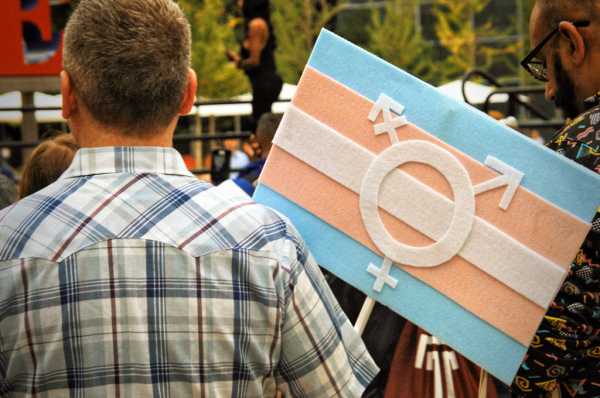
Though they are often conflated by many Americans, and particularly Republicans, sex is not the same thing as gender.
Sex is determined by the biological configuration of chromosomes. Gender is our individual identity: one that can be fluid or fixed. Respecting and honoring this difference is key to respecting the rights of transgender people.
The Trump administration is hoping to erase these distinctions, via changing the Department of Health and Human service’s interpretation of Title IX. As the New York Times reported over the weekend, the administration “is considering narrowly defining gender as a biological, immutable condition determined by genitalia at birth,” and that “any dispute about one’s sex would have to be clarified using genetic testing.”
But as Jack Turban, a resident physician in psychiatry at Massachusetts General Hospital who researches gender identity, told me in an email, “There is no ‘scientific definition’ of gender. Things like anatomy and chromosomes just don’t cut it. The only way to know someone’s gender is to ask them.”
The administration’s insistence on using genitalia to define gender, he adds, also doesn’t make sense for people born with genitalia that are “not clearly defined as male or female.” It’s possible for some people to have XY sex chromosomes, but their bodies neither respond to testosterone nor develop into that of a typical male (known as androgen insensitivity).
So, the Trump administration’s proposal is not grounded in science, or reality. And if the government conflates sex with gender, it could mean that civil rights protections will no longer apply to the 1.4 million Americans who are trans, and that discrimination against them could increase.
They already experience a lot of prejudice: A 2017 NPR/Harvard poll found that 38 percent of transgender Americans have experience slurs, and 22 percent said they “have been told or felt they would be unwelcome in a neighborhood or building because they are transgender.” Transgender people are often targets for violence.
I don’t want to understate how painful the HHS policy changes would be. But there is some hope that the discrimination they face doesn’t have to go on forever.
It’s worth to revisit a small glimmer of hope from psychological research on changes in attitudes toward transgender people. These insights may not change the mind of the president. But they can help change the minds of our neighbors.
What it takes to reduce anti-trans prejudice
In 2016, the journal Science published a remarkable bit of insight: It’s possible to reduce prejudice and sway opinions on anti-transgender legislation with one 10-minute conversation. What’s more, the researchers found that the change of heart can last at least three months and is resistant to anti-transgender attack ads.
The study is titled ”Durably reducing transphobia: A field experiment on door-to-door canvassing,” and it was the first large-scale, real-world experimental effort that shows lasting opinion change is possible.
It worked because the canvassers in the study did a simple thing: They listened to people with anti-trans views.
Dave Fleischer, a longtime political organizer, calls it deep canvassing. The key to it is that Fleischer has the voter do most of the talking.
Instead of pelting voters with facts, “we ask open-ended questions and then we listen,” Fleischer told me. “And then we continue to ask open-ended questions based on what they just told us. … “The key part of this is having people think back on their real, lived experience in an honest way.”
In talking about their own lives, the voters engage in what psychologists call “active processing.” The idea is that people learn lessons more durably when they come to the conclusion themselves, not when someone “bitch-slaps you with a statistic,” says Fleischer. Overall, it’s a task designed to point out our common humanity, which then opens the door to reducing prejudice and changing opinions.
Here’s a video example of deep canvassing. It’s of a real voter and a canvasser from the Leadership LAB, a program of the Los Angeles LGBT Center. The woman in the video starts off ambivalent on transgender issues. But through deep canvassing, the activist is able to turn her around.
Specifically, the canvassers ask the voters to recall a time when they were discriminated against. And then toward the end of the conversation, the canvassers nudge the voters into thinking about how that experience can relate to the plight of transgender people. The idea is that people learn lessons more durably when they come to the conclusions on their own.
In the video above, notice how the voter starts to come around on the issue when the canvasser asks if she’s ever been on the receiving end of discrimination. She talks about being picked on at work and feeling different. He responds by telling his own story of being discriminated against for being gay. It’s a real heart to heart between strangers.
And in that moment, the canvasser points out that a transgender nondiscrimination law would help people who feel discriminated against at school or work.
”Oh, okay, that makes a lot of sense,” she says.
Human emotions are universal. They help us connect to one another.
Fleischer has shown me several videos the LAB has shot of real encounters his canvassers have had with voters. They’re really compelling demonstrations of how attitudes can change in the course of a conversation.
In another video shot in Miami, a young canvasser named Virginia approaches an older South American man named Gustavo. Virginia is tattooed up to the neck, and Gustavo is wearing a sleeveless undershirt tucked into khaki pants. Virginia is a gender nonconforming person who identifies as neither male nor female.
In the beginning of their conversation, Virginia asks Gustavo how likely he’d be to support transgender rights legislation. Gustavo says he wouldn’t support it because he’s worried about predatory men using the law as an opportunity to enter women’s bathrooms.
Virginia asks why he feels that way.
”I’m from South America, and in South America we don’t like fags,” he tells Virginia.
This next moment is crucial: Virginia doesn’t jump on Gustavo for the slur, and instead says, “I’m gay,” in a friendly manner. Gustavo doesn’t recoil. Actually, he becomes more interested.
Gustavo and Virginia go on to discuss how much they love their partners, and how that love helps them overcome adversity. Gustavo tells Virginia that his wife is a disabled person. “God gave me the ability to love a disabled person,” he says, and that taking care of one another is why love matters.
”That resonate a lots with me,” Virginia responds. “For me, these laws, and including transgender people are about that. They’re about how we treat one another.”
Now that Gustavo is in a place where he’s more open, Virginia asks him to imagine what the worst thing could happen if he used a bathroom with a transgender person. He admits he wouldn’t be scared. Then comes the breakthrough. “Listen, probably I was mistaken,” he says of his original position on trans rights.
Making a human connection leads to lasting changes in attitudes
This all may sound a bit saccharine, but the research in Science suggests it works. Political scientists David Broockman and Josh Kalla analyzed the effectiveness of deep canvassing. They found these conversations not only move people to be supportive of trans people and trans-inclusive legislation — but that effect also persists three months out. (Read more about their study design here.)
In the paper, Broockman and Kalla describe the lasting opinion change between the experimental and control group as comparable to the public’s changing attitude toward gay and lesbian people that occurred between 1998 and 2012. “That two decades of opinion change took place during a 10-minute conversation, and it persisted for at least three months — that’s a big effect,” Kalla told me.
But the main message of the strategy couldn’t hurt to try: Listen to people, get them to think about their own experience, and highlight your common humanity. The Trump administration proposal denies transgender people the right to assert who they are, and potentially furthers public misunderstanding. There’s some hope in knowing there’s at least one scientifically validated way to fight back.
Sourse: vox.com






